Hydroponics and Gardening without Soil
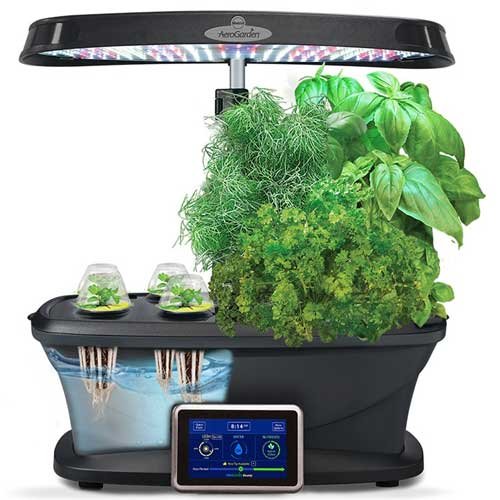
Aerogarden
Lots of people have heard of hydroponics. At the very least, many have seen it at work. One of the most widespread kits called Aerogardens are available for purchase. However, what about the other kinds of soilless growing? Several types of soilless gardens have been developed and used for years now. Many may not realize all of the ways in which plants can be grown without soil.
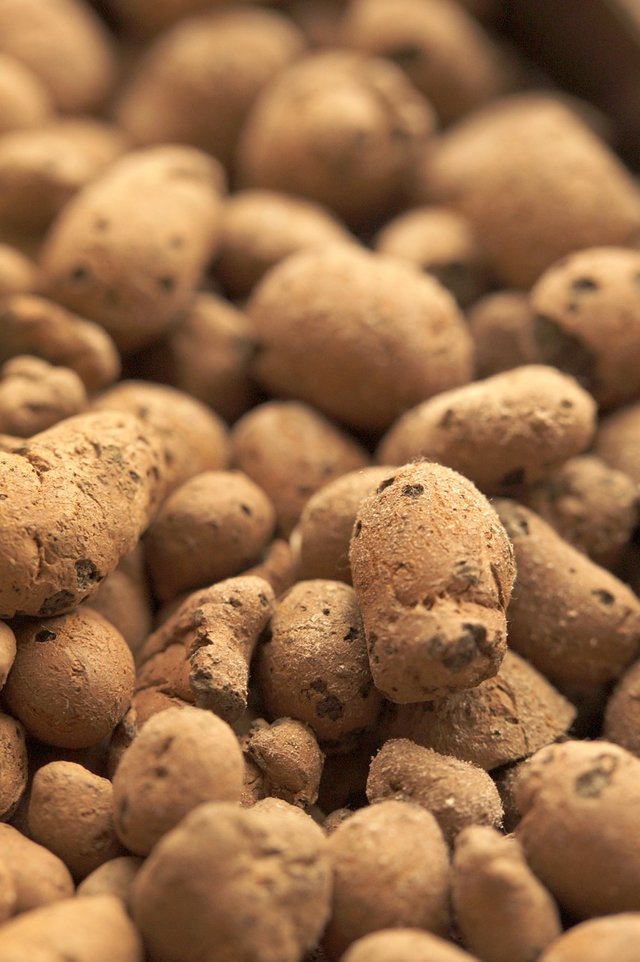
Clay Pellets
It has always been assumed that roots need a soil type medium to grow, and while this is true in many situations, we have managed to provide new media for growth. Clay pellets, floating in water, foam, and many more are available. In the end, it is just the medium for the roots to grow. The important part is the nutrients and air.
These soilless methods can be used in our kitchens, labs, gardens, and commercial areas. The possibilities are vast and growing. Instead of having to grow flowers exported in bouquets in soil, hydroponics can be used. This way one large container of water can hold multiple plants. Plants can be duplicated by cuttings without the need of using soil. Produce can be grown indoors year-round with artificial lighting. This is something that NASA has shown a great interest in. Here we will cover some of the main branches of soilless growing, and even some of the techniques that have been created from those.
Deep-Water Culture with Bubbles/Aeration
Deep-water culture (DWC) is perhaps the most widely known method being discussed here. It is also the one that is sold commercially. The fact that it is easy to set up, and widely known has resulted in kits being available. Some areas even have hydroponic stores that carry these.
At the basics, a deep-water culture consists of a reservoir of water, air pump, growth medium, and net pot. The idea here is to have the plant roots submerged in the container of water. This water contains all of the nutrients that would normally be absorbed through the soil.
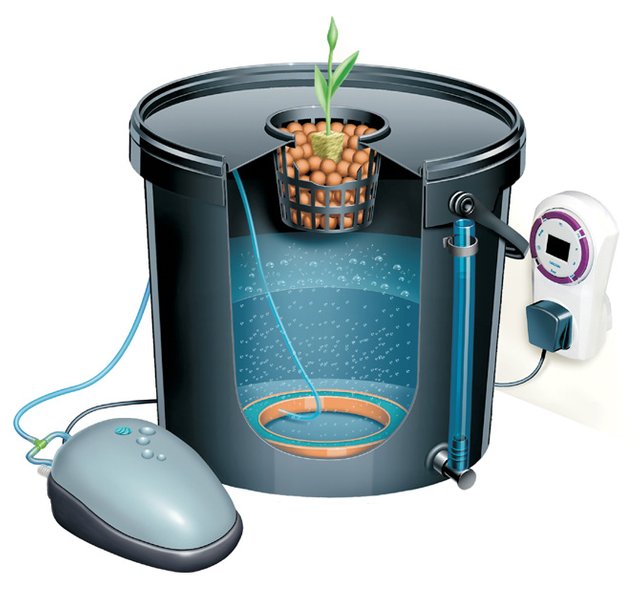
Single Plant DWC Diagram
The issue comes with the very thing this relies on; the water. Many plants will rot when overwatered, and many also need specific PH levels. This is where the air pump comes into play. If the roots are constantly being agitated with bubbles, then rot can be managed. This gives the roots the necessary air to do so.
PH is managed with a PH test kit. Anyone with a fish aquarium will experience the same thing. While selecting plants the PH comes into play again though. A plant that needs a PH between 5.5 and 6.5 cannot be grown with a plant that needs a PH outside that range. Different plants can be grown together, but research will be necessary when selecting species.
Some have started to use bubbleponics as a term for top fed cultures. The term deep-water culture itself is also used in a few different ways. The main idea is still one reservoir and an air pump. Perhaps this is where the name bubbleponics came from.
Aeroponics
The general idea behind aeroponics is to have the plant suspended instead of submerged. Instead of having an air pump, the roots are misted with a water nutrient mixture. The roots are not growing in a medium like in hydroponics, but are hanging bare to receive the nutrients.
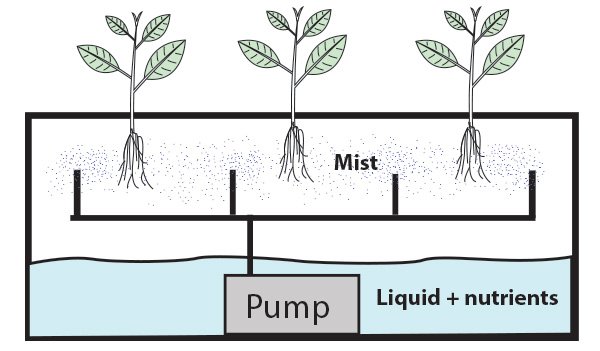
Aeroponics Diagram
Even though it sounds complicated, this technique can be created in a bucket like most of the others. A setup similar to deep-water culture is created, except there is no medium or water in the reservoir. The plants hang from the top, and some form of pump with a mister is on the bottom. A timer will set how often the roots get sprayed.
There is a slight variant regarding fog called fogponics. The water is vaporized instead of just misted. This results in a finer spray than before. It is suggested that these smaller particles can be absorbed differently by the roots.
Aquaponics
Aquaponics can be seen as hydroponics with animals added. It could also be aquaculture with plants added. Either way, to explain aquaponics, aquaculture needs to be explained. This is not really as complex as it may sound, but in essence, aquaculture is raising aquatic animals often for food. Whether it be fish or invertebrates.

Aquaponics Diagram
During the process of raising the animals, waste is produced. Instead of relying solely on manmade filtration, plants can be added. This creates a sort of balance between the two systems. The animals produce waste, and the plants absorb some of it. This acts as the nutrients that would have been added in hydroponics, and the filtration that was needed in aquaculture.
In essence, this idea could be viewed in a home aquarium. The live plants are gaining nutrients from the animals you are caring for. This can help with ammonia maintenance. While not quite a full environment, it does emulate one.
Ebb and Flow
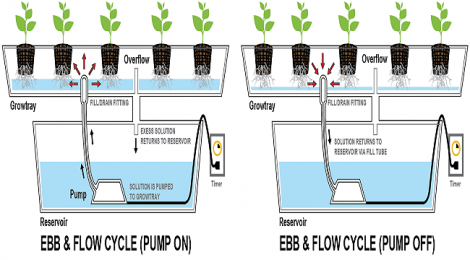
Ebb and Flow Diagram
Ebb and flow could be easier understood as flood and drain, but this method emulates standard watering in a way. A standard plant may be watered once a week manually, and then allowed to dry fully before watering again. With ebb and flow, the plants are contained similarly to a deep-water culture, but are not in a reservoir of water. A pump will flood each plant with nutrient rich water, and then allows them to drain. At a set interval later, the plants are flooded again. It is easy to see how the roots get the required amount of air. The chance of rot will be reduced with this. This system is one of the more popular, and so it has some variants to choose from.
Drip System
Perhaps the drip system can be seen as ebb and flow with moderation. Instead of a sudden flood and drain, the nutrient water is dripped onto the plants medium. With hydroponics, a water pump is used to pump the water out of a reservoir similar to ebb and flow. Small tubing drips the nutrient water onto the individual plants.

Drip System Diagram
Continuous Flow
The water still drains away into the original reservoir. There is not a shut off period for the water though. This also takes away the need for a timer. In this system, the water is constantly rushing over the roots. As the water drains through the planting medium, it gets stored back into a reservoir. A pump then brings it back to the top to cycle through again.
One popular way to do this is with something like PVC pipe. Laying on its side, holes can be made in the pipe for the plants to sit in. The water begins at one end, and drains through the other. The roots of each plant are within the pipe. This makes it very popular with the tiny house movement in the United States. Instead of having to have one plant with a set amount of space and soil, you can have one set up with several plants.
Nutrient Film System
Nutrient film system is an interesting one. This time we take the continuous flow system, and reduce the amount of nutrient water flowing by the roots. The plants are suspended like normal, and a majority of the roots are not submerged in water. The bottom of the container has a thin layer of nutrients in it. This creates the nutrient film part of the name, and the rest of the roots are placed into it.
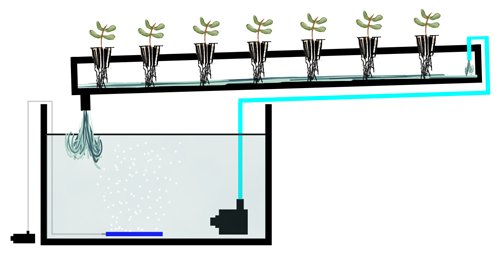
Nutrient Film Diagram
This makes for a rather interesting system. It also provides all of the plants needs at the same time. Most of the roots have access to oxygen, and some can absorb nutrients as needed. There is not a huge fight against too much water either.
Static Water
While this is technically a variant of the other water cultures, a static water culture is something that many houseplant keepers do without even knowing it. This could take place when someone grows a peace lily in a vase full of water. Or even when someone grows a plant cutting in a glass of water by the window.
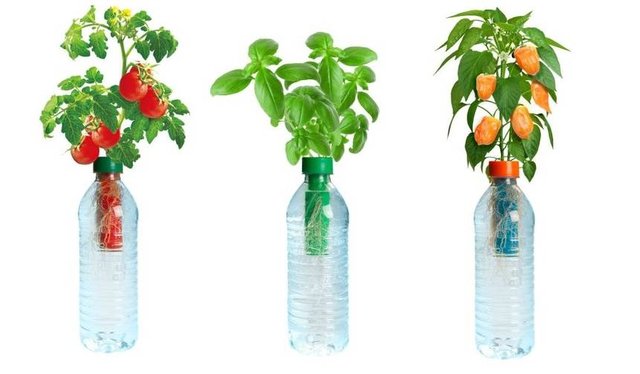
Static Water Example
All of this being said, it will most likely not be suited to many plants or large-scale operations. The lack of movement and air can cause root rot. This technique is more suited to small experiments and houseplants.
Recirculating Deep-Water Culture
A recirculating deep-water culture is mostly as it sounds. When taking deep-water culture, it was discovered that using an inline pump to circulate the nutrients provided better results than individual buckets with air stones. The circulation oxygenates the water beyond what was originally occurring, and the nutrients can be managed easier.

Recirculating DWC Diagram
The setup for this would be something along the lines of multiple single plant containers set up as if being used for a standard deep-water culture. This could be a bucket with an air stone in the bottom full of water and nutrients. This air stone is connected to an air pump similar to those used in aquariums, but larger ones can be used so multiple stones are connected to one pump. The lid would have a whole for the net pot to fit in. Some sort of medium would be in this pot, and finally the plant.
The difference comes in when we begin to connect the individual planters. Instead of each bucket being separated, they are connected so they share one separate reservoir of water. This could be with something such as a pipe between buckets. A water pump is added to circulate the water between buckets.
One idea that comes to mind would be to set up a standard deep-water culture with all of the plants in one large container. Something like a storage tote could be used for this. Air stones are added to the bottom, and if desired, water pumps could be added to create something similar to the recirculating system. While this would not technically be a recirculating DWC, it would function similarly.
Wick System
Although a pretty simple technique, the wick system can be very useful. It is more of a way to keep plants planted in soil moist. A simple way to implement this would be to have a small container of water next to a small plant. Get something to use as a wick. This could be a piece of paper towel, cotton ball, or similar items. Link the water to the plant container, and let capillary action do the rest. The water will travel from the first container, through the wick, and into the plants container.
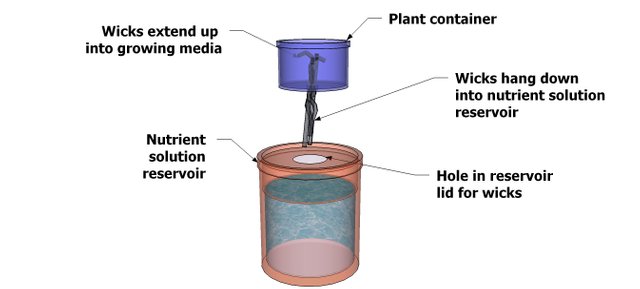
Wick System Diagram
This is used in some of the self-watering pots that are sold in stores. There are also some popular grass growing kits for children that involve this technique. They are often shaped like a head, and have grass for hair. The head is soaked for the initial watering, but the wick system keeps it moist. All that needs to be done is keeping the reservoir filled.
It is not necessarily the best choice for larger plants, but it is rather interesting for small ones. It could provide for a great children's science experiment. Or even a way to keep a houseplant moist.
Links for more information on soilless gardening:
Aeroponics (just abstract of article)
Aquaponics
Nutrient Film Technique (just abstract of article)
Glad you like it :) Thanks
Perfect
I enjoyed the post and resteemed it, If you would be kind enough to check out my blog i recently made a few on gardening, just one today on composting you may like enough to vote back :)